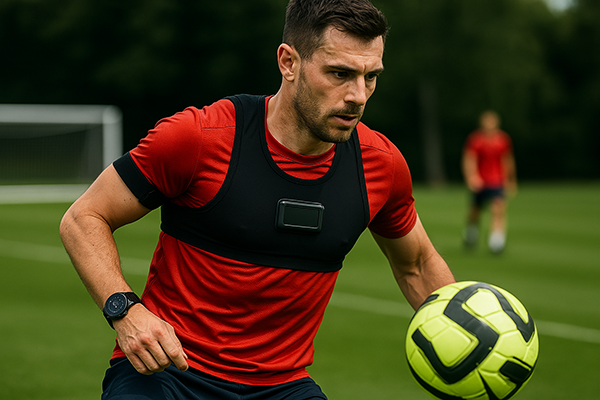Trends in Football Gear: How Wearable Devices Are Transforming Player Training

Football is evolving rapidly, not only in tactics and athleticism but also in technology. Among the key changes are wearable devices that have revolutionised the way players train, recover, and improve performance. These gadgets are no longer optional add-ons—they are fundamental tools integrated into the daily routines of elite teams. As of February 2025, wearables are redefining modern football training with precision data, real-time feedback, and advanced health monitoring.
Integration of Wearables in Daily Training Routines
In professional football clubs across Europe and beyond, wearable technology has become standard. Players wear GPS trackers, smart vests, and biometric sensors during practice sessions to monitor distance covered, speed, acceleration, and heart rate. These insights help coaches understand a player’s physical output and adjust training loads accordingly. Rather than relying on intuition, trainers now make data-driven decisions to optimise performance and reduce injury risk.
Football federations, such as the English FA and UEFA, have embraced wearable devices as essential tools in athlete management. Clubs like Manchester City and Bayern Munich integrate systems like STATSports Apex and Catapult into their programmes. These tools provide minute-by-minute tracking of workload, which allows staff to compare performance with baselines, ensuring peak condition ahead of matches.
As of 2025, recovery protocols have also been fine-tuned using wearables. Sleep monitors, Oura Rings, and Whoop Bands give detailed insights into recovery quality, rest patterns, and readiness levels. This information supports decisions around rest days, training intensity, and nutritional strategies—maximising every aspect of player care.
Data-Driven Training Plans
Wearables have enabled hyper-personalised training programmes based on each player’s unique physiological data. Coaches no longer apply uniform drills; instead, they adapt sessions to suit individual recovery states, fatigue levels, and muscle exertion metrics. Such personalisation improves efficiency and ensures long-term athlete development.
With real-time monitoring, coaching staff can intervene during sessions. For instance, if a player’s heart rate spikes unexpectedly or exceeds safe exertion thresholds, they are immediately pulled aside to prevent overtraining or cardiac strain. This level of responsiveness was unimaginable just a decade ago.
Furthermore, the data collected over time helps identify long-term trends. Recurring patterns of fatigue, declining sprint speeds, or asymmetry in movement can signal the early onset of injuries. Early detection translates into better prevention strategies and longer careers for top-tier players.
Health Monitoring and Injury Prevention
Wearable devices now play a critical role in injury prevention strategies. Soft tissue injuries, such as hamstring strains, are among the most common in football. However, with constant biomechanical data input from smart clothing and sensors, coaches can predict risk levels with greater accuracy and implement preventive measures in advance.
These systems don’t just stop at external metrics—they increasingly include internal load monitoring. Devices like heart rate variability (HRV) trackers and hydration sensors offer insights into stress, fatigue, and even illness. When HRV drops significantly, it often indicates a need for rest or further medical evaluation, keeping players safe and competitive.
Medical teams now collaborate closely with data analysts to assess a player’s risk profile. The integration of artificial intelligence in wearable ecosystems can even issue automated alerts when an athlete exhibits warning signs—improving communication between coaching, medical, and performance departments.
Return-to-Play Protocols
Recovering from injury is no longer a matter of guesswork. Return-to-play decisions are made with the support of data collected during rehab. Wearables track metrics like muscle load, joint mobility, and acceleration capability to determine whether a player is fit to return or still needs time.
This data ensures that players don’t return too early, which is a major cause of reinjury. By comparing pre-injury and post-rehab metrics, medical staff can assess whether a player is truly back to match condition. This scientific approach reduces the likelihood of setbacks.
Moreover, players themselves can access personalised dashboards, helping them understand their own recovery journey. Empowering athletes with data promotes engagement and accountability, strengthening their role in the recovery process.

The Future of Wearables in Football
As of early 2025, innovation in football wearables shows no signs of slowing. Upcoming technologies include smart boots with pressure sensors, neural interface trackers, and AI-driven analytics systems that predict performance trajectories and health outcomes. These tools are set to further refine how footballers train and compete.
One particularly promising advancement is the use of embedded microchips in training kits. These provide real-time telemetry without the need for external vests, making them more comfortable and less intrusive. Already being trialled in several youth academies, such technology is expected to be mainstream within two years.
Another significant development is the integration of augmented reality (AR) feedback. During drills, players can receive visual cues on smart glasses, helping them correct positioning, foot placement, or posture on the fly. This hands-free interaction with coaching insights accelerates learning and decision-making.
Ethical and Privacy Considerations
Despite the benefits, the widespread use of wearables raises concerns about data privacy and player autonomy. Clubs collect vast amounts of sensitive biometric data, and there’s growing debate about who owns this information—teams, governing bodies, or the players themselves.
Governing bodies such as FIFPro have begun advocating for clearer policies around data rights. Players are pushing for increased transparency and control over how their information is stored and shared, especially in contracts and transfer negotiations where fitness data could influence decisions.
It is essential that innovation in football technology is matched with ethical frameworks to protect those who use it. As wearables become even more deeply embedded in the sport, ensuring fair and safe data practices will be vital to preserving trust between players and clubs.



